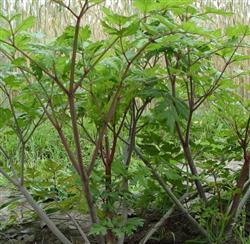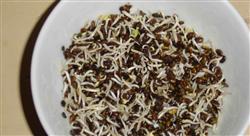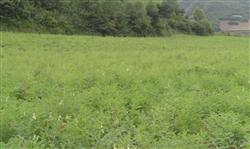How to cultivate Radix Astragali?

How to cultivate Astragalus membranaceus? Please introduce guidance Traditional Chinese medicine planting is a way for farmers to become rich. With the development of medical and health care in China, more and more people will invest in the production of traditional Chinese medicine. In order to obtain high yield, high quality and high benefit of Chinese herbal medicine, the cultivation techniques of Astragalus membranaceus are introduced below. Astragalus membranaceus for leguminous perennial herbs, produced in northeast, north china and other places. The root is used as medicine, which has the functions of invigorating qi and consolidating exterior, diuresis, detumescence and toxication, and promoting granulation. Mongolian Astragalus membranaceus and membranous pod Astragalus membranaceus, are genuine. Astragalus membranaceus is a deep-rooted plant with a taproot length of 20-80 cm. Like cool climate, drought and cold tolerance, fear of heat and waterlogging, wild in the grassland dry sunny slope, seed germination does not like high temperature, 14-15℃ for germination temperature. Seed germination and seedling stage need sufficient water, otherwise it will not emerge or die due to drought. Astragalus mongolica flowers in late may, fruit in late june to mid-july; Astragalus membranaceus flowers in late june, fruit in august to mid-september. Flourishing soil should not be too dry, so as not to drop flowers and fruits, seedlings thin, afraid of strong light, a little shade, easy to survive, adult plants and growth period like drought and sufficient sunshine. I. Cultivation techniques 1. Land selection and preparation. Astragalus like cool, drought, cold, afraid of heat, afraid of waterlogging, avoid high temperature. Its taproot grows vertically downward, appropriate chooses drainage to be good, sunny, the loam with deep soil is optimal. After selecting the land, the ploughing depth is 30-40 cm, 3000-4000 kg of farm manure and 25-30 kg of phosphate fertilizer are applied in combination with the land preparation, and the ridge (or ridge) is formed after the rake is leveled. Generally ridge distance 50-60 cm, ridge width 1.2 meters. When making a ridge, it is best to open a deep groove every two ridges, 45-50 cm deep; open a shallow groove between the two ridges, the depth of the groove is 20 cm, as a working channel, can be appropriately relaxed, the ridge height is 15-20 cm. 2. Seed treatment. Astragalus seed coat hard, difficult to germinate after sowing, sowing should be carried out before seed treatment. soak that seeds in warm wat at 50 DEG C, stirring, soaking for 24 hours aft the water temperature is lowered to 40 DEG C, washing, spreading on a wet towel, covering with a wet cloth for germination, and sowing after germination; or putting two times of river sand into the seeds, kneading, scratching the seed coat, and rapidly germinating; or soaking the seeds in 70-80% sulfuric acid for 3-5 minutes, rapidly washing in flowing water, washing and sowing after the seeds are slightly dried, and the germination rate reaches more than 90%. 3. Sowing. The suitable temperature for seed germination is 14-15℃, and it can be sown in spring, autumn and summer. Spring sowing is in the middle and late March; autumn sowing is sown before freezing, and seedling emergence in spring of vertical year; in wind-blown arid area, spring and autumn sowing is difficult to protect seedlings, and it is easy to attract pests at seedling stage in spring. Therefore, the use of summer 6-7 months sowing, the emergence of neat, strong seedling growth. Drill sowing, in the ridge on the 3 cm sowing ditch, the seeds evenly scattered into the ditch, the seeds mixed with appropriate amount of fine sand, covered with soil 1-1.5 cm, the seeds covered tightly, slightly suppressed. Sowing amount per mu is 1-1.5 kg. Flat ridge planting can also be, but more disease, root shape is not as good as ridge planting. In production, seedling transplanting is commonly used. The direct seeding seedlings are planted according to the plant spacing of 20×40 cm, the ditch depth is 10-15 cm, the seedlings are placed in the ditch, and the soil is covered after sowing. About 15,000 seedlings are used per mu. 4. Cultivation management. 1. Intertillage, weeding, thinning and seedling determination. Astragalus seedlings grow slowly and often grow together after emergence. Therefore, seedling height 4-5 cm, should be timely intertillage weeding. When the seedling height is 7-8 cm, the second intertillage weeding is carried out. When the seedling height is 10-12 cm, the membranous Astragalus membranaceus is 9-10 cm, and the Mongolian Astragalus membranaceus is 6-7 cm. 2. Topdressing. In the first and second years, it grows vigorously and its roots grow rapidly. It can be combined with intertillage weeding and fertilization 1-2 times a year. 500-1000 kg of manure shall be applied per mu furrow. If chemical fertilizer is applied, phosphorus and potassium fertilizer shall be given priority. ③ Irrigation and drainage Generally do not irrigate, but after sowing in case of drought, should be timely irrigation, in order to promote seed germination. In rainy season, the humidity is too large, the roots grow slowly downward, and the roots are easy to rot, so the drainage should be dredged in time to facilitate the normal growth of the roots. 5, pest control. 1) Disease. The main disease is powdery mildew. The diseased leaves of the affected plants are early yellow and fall off. The disease spreads when the temperature is 19-20℃ and the air relative humidity is 40%--60%. The pathogen overwinters on the host stump. Control method: When clearing garden to deal with sick and disabled plants, use two important agricultural control measures: spray 50% thiophanate-methyl 1000 times solution or BO-10 biological agent in the occurrence period. Purple feather disease, damage roots, cause root rot, plant from top to bottom wilt and finally the whole plant died. The diseased plants should be uprooted and burned, and the diseased nests disinfected with lime powder. At the same time, other pest control should be strengthened. (2) Pests 1 pod borer. It usually occurs from late June to late September. Adults lay eggs on the tender pods or flower buds of Astragalus membranaceus, and larvae bite seeds in the pods after hatching. The mature larvae emerge from the pod and overwinter in the soil. Control method: spray 90% trichlorfon 1000 times solution or 40% omethoate 800~1500 times solution at flowering stage. Every 7 days until the seeds are ripe. 2. Pod flies. Larvae from the tender shoots gradually downward borer stem damage, resulting in the top tender shoots gradually withered, plant easy to meet the wind that is broken. Control method: spray 90% trichlorfon 1000 times solution or 25% phoxim emulsifiable concentrate 800 times solution once every 7 days for 3~4 times continuously during the occurrence period (June to July). 3. Aphids. It is a common pest in Astragalus membranaceus producing areas. It mainly harms the stems and leaves of Astragalus membranaceus, gathering in clusters on the back of leaves and young stems to suck stem and leaf juice. Serious cause stems yellow, leaf curl, flower drop pod, seed shriveled, leaves early fall off, so that the whole plant dry death. Control method: spray control with 40% dimethoate emulsifiable concentrate 1000 times solution, or 1000 times solution of net all over again. ④ Astragalus seed bee. Astragalus seed wasp is a mixed population of Astragalus seed wasp, Astragalus seed peak from Inner Mongolia, Astragalus seed wasp from Beijing, Astragalus seed wasp from Beijing, Astragalus seed wasp from Beijing and Astragalus seed wasp from Beijing. Their main habits are roughly the same. At the green fruit stage of Astragalus membranaceus, larvae feed on seed flesh within the race, leaving only seed coat, the damage rate is generally 10%~ 30%, serious cases can reach 40%~50%, host plants are mainly Astragalus plants, there are cases of transfer host damage. Control method: clear garden, reduce insect source; spray 40% dimethoate emulsifiable solution 1000 times in the green fruit stage of Astragalus membranaceus. 6. Harvest and processing. 1. The seeds will bloom and bear seeds in the second year after sowing. When the pods droop yellow ripe, brown seeds can be harvested. Seed maturity is different, should ripen with pick. If the harvest is too late, the pod dehisces and the seeds are lost. After harvesting, the fruit pods are dried and threshed, and impurities are removed and stored for later use. ② Harvest Astragalus membranaceus is harvested 2-3 years after sowing, Astragalus mongolica is harvested 3-4 years after sowing, and the quality is generally poor due to short age. After harvesting the withered parts of the ground in autumn, first cut off the plants on the ground, then dig out the roots, and dig deep to prevent digging off the main roots and damaging the outer skin. It can be dug up from one end of the ground, cut out sections and overturned. 3. After digging out the processed roots, remove the soil, cut off the rhizomes (reed heads) and fibrous roots while fresh, dry them in the sun until they are half-dry, tie the roots straight into bundles, and then dry or dry them into raw Astragalus membranaceus. The finished product is stored in a ventilated dry place. Generally, the dry goods collected per mu are 150-250 kg. Click to get more Astragalus planting technology Click to get more herbs planting technology
- Prev

How to treat seeds before planting Astragalus membranaceus?
How to treat seeds before planting Astragalus membranaceus? Please give guidance before planting Astragalus seeds can be treated as follows: first put the seeds into boiling water quickly stir for 1min, immediately add cold water, adjust the water temperature to 40℃, soak for 2h, then remove, cover with damp cloth or sack, etc., stuffy for 8 h-12h, wait for the seeds to swell or when the skin ruptures.
- Next

How to manage the cultivation of Radix Astragali?
How to manage the cultivation of Radix Astragali? Please guide the cultivation of Radix Astragali can refer to the following methods: first, growth habits. Astragalus membranaceus has strong adaptability, general soil can be planted, drought-resistant, cold-resistant, and the soil layer is deep, loose and fertile. Second, cultivation methods. You can sow seeds in spring, summer and autumn. Soak the seeds in warm water before sowing.
Related
- Fuxing push coffee new agricultural production and marketing class: lack of small-scale processing plants
- Jujube rice field leisure farm deep ploughing Yilan for five years to create a space for organic food and play
- Nongyu Farm-A trial of organic papaya for brave women with advanced technology
- Four points for attention in the prevention and control of diseases and insect pests of edible fungi
- How to add nutrient solution to Edible Fungi
- Is there any good way to control edible fungus mites?
- Open Inoculation Technology of Edible Fungi
- Is there any clever way to use fertilizer for edible fungus in winter?
- What agents are used to kill the pathogens of edible fungi in the mushroom shed?
- Rapid drying of Edible Fungi

